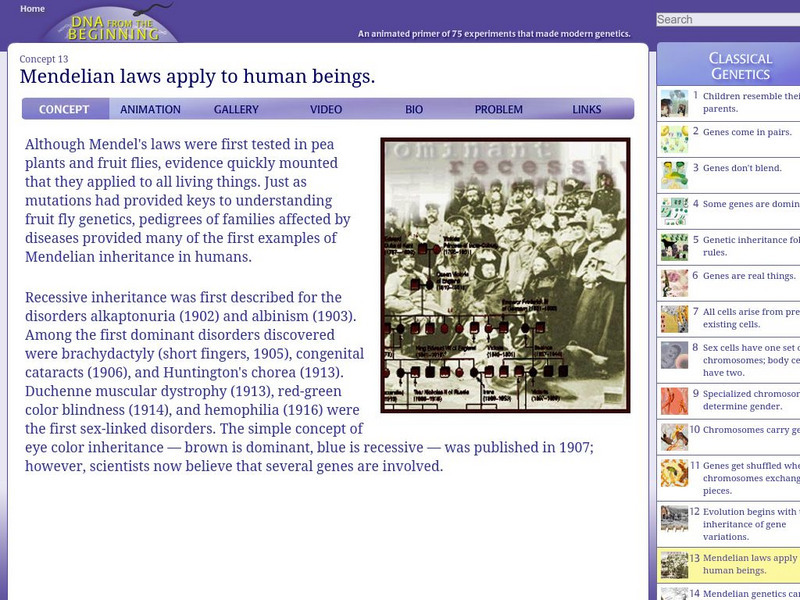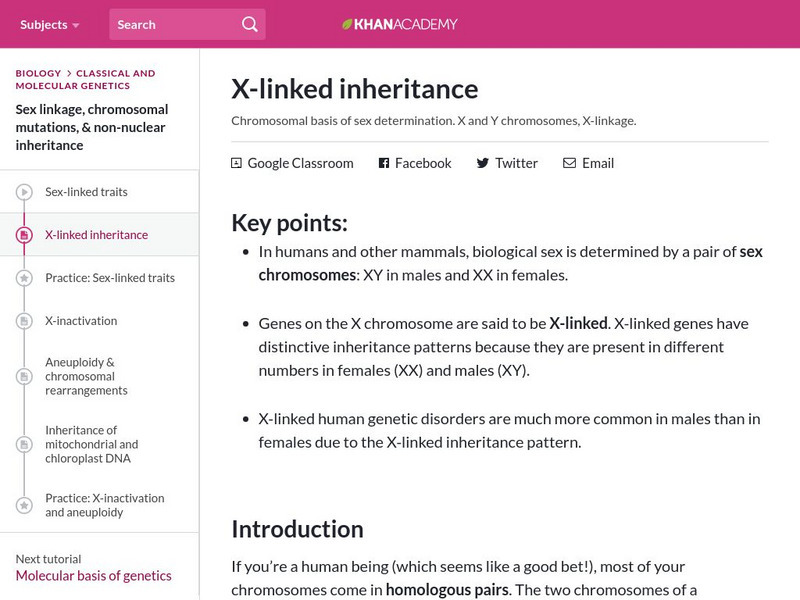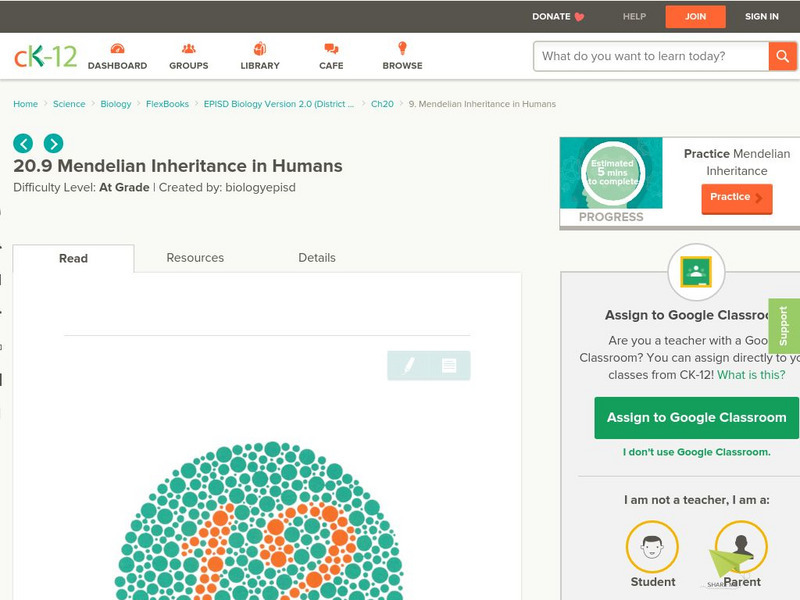Hi, what do you want to do?
Curated OER
Biology: Genetics and Heredity
Seventh graders explore the connection between genetics and heredity by examining the cellular structure. Among the numerous activities to engage students are drawing DNA molecules, vocabulary puzzle sheets, and predicting possible...
Curated OER
Dragon Genetics Lab-Principles of Mendelian Genetics
Students study genetic traits using popsicle sticks as chromosomes. In this biology lesson plan, students explain how traits are inherited from parents. They differentiate dominant and recessive genes.
Cold Spring Harbor Laboratory
A Genome Is an Entire Set of Genes
Today researchers identify a gene suspected of causing a genetic disease in a matter of days rather than years, thanks to the Human Genome Project. Young scientists learn about the Human Genome Project and the scientists who designed the...
Curated OER
Human Genetics
In this biology worksheet, 9th graders create a Punnett square to show the possible offspring of a carrier female and a normal male for color blindness. Then they draw a pedigree for the family and indicate whether the daughter is...
Curated OER
The Genetics of Parenthood
Learners draws the child's face and compares "mother's" and "father's" perception of characteristics. One student draws the child's face; partner writes a biography of the child at age 30- what is the child like, what have they...
Curated OER
Human Genetic Disorder Probabilities
In this genetic disorders worksheet, students complete punnett squares for six different human genetic disorders. They predict the outcome of the offspring including the phenotypes and genotypes of each.
Curated OER
Mendelian and Non-Mendelian Heredity
Tenth graders discuss their physical features, and why they look the way they do. They listen as the teacher discusses DNA, alleles, and dominant or recessive genes. Students perform an experiment with different colored markers...
Curated OER
The Genetic Basis of Neurological Disorders
Students explore neurological disorders. They examine the presence and absence of discernible genes. Students describe neruological diseases and draw faces of affected persons. They play a human neurology disorders learning game.
Curated OER
Biology - Life Cycles Game
Pupils develop a working vocabulary of terms related to the life cycle. In small groups, students play the life cycle's game which consists of matching and defining vocabulary. Directions for creating the game board are included with...
Curated OER
The Genetic Basis of Neurological Disorders
Young scholars describe some aspects of known genetic defects on the human neurological condition. They participate in a variety of exercises including drawings, games, and analogies.
Curated OER
Drosophila Melanogaster
Students cross wild type flies and mutants, both purchased from a biological supply house (Carolina Biological Supply or Wards, for example) in groups from lesson one.
Curated OER
Chromosomes
In this chromosomes instructional activity, students complete a crossword puzzle with 33 questions about genetic mutation in chromosomes. They identify traits associated with certain genes.
Curated OER
Cells and Cancer
Students idenitfy that cancer is a growth of mutated cells and that cancer cells are only one type of cell that causes disease in our body. They also identify that all eukaryotic cells contain a nucleus, cytoskeleton, and a cell...
National Health Museum
Access Excellence: Sex Linked Inheritance: Drosophila
Here are graphics illustrating an experiment with drosophila fruitflies. Sex-linked inheritance is demonstrated here using eye color alleles on X chromosomes. Site by Access Excellence.
CK-12 Foundation
Ck 12: Life Science: Sex Linked Inheritance
[Free Registration/Login may be required to access all resource tools.] What determines if a baby is a male or female? Recall that you have 23 pairs of chromosomes-and one of those pairs is the sex chromosomes. Everyone has two sex...
University of Arizona
University of Arizona: Sex Linked Inheritance
This site from the University of Arizona provides great information on a sex-linked inheritance problem set. This is a very good site to practice what you know about sex-linked problems. Each link is a problem.
CK-12 Foundation
Ck 12: Life Science: 3.13 Sex Linked Inheritance
Learn about the traits that are linked to genes on the sex chromosomes.
Cold Spring Harbor Laboratory
Dna From the Beginning: Sex Linked Hemophilia in the Royal Romanov Family
An animated pedigree clearly explains the way hemophilia was inherited in the Romanov family. Interpreting pedigrees and sex-linked crosses should be much easier to understand after going through this tutorial.
University of Arizona
University of Arizona: Sex Linked Inheritance Set 2
This site, provided by The University of Arizona, gives a good set of genetics problems that involve sex-linked genes. Great to review what you know! Links are provided to access the various subjects covered in this problem set.
OpenStax
Open Stax: Anatomy & Physiology: Patterns of Inheritance
Students learn about patterns of inheritance including genotype and phenotype, and then learn about the inheritance of autosomal dominant and recessive and sex-linked genetic disorders.
Khan Academy
Khan Academy: X Linked Inheritance
Find out about the chromosomal basis of sex determination, X and Y chromosomes, and X-linkage.
CK-12 Foundation
Ck 12: Episd: Mendelian Inheritance in Humans
[Free Registration/Login may be required to access all resource tools.] While studying genetics, students will investigate sex-linked genes and what inherited diseases are associated with the genes. Students will also explore pedigree...
CPALMS
Florida State University Cpalms: Florida Students: Complex Modes of Inheritance
A tutorial reviews polygenic and multiple alleles, Punnett Square, sex-linked trait, and inheritance patterns. Follow the slides to ensure comprehension of inheritance.
CK-12 Foundation
Ck 12: Biology: Mendelian Inheritance in Humans
[Free Registration/Login may be required to access all resource tools.] Covers Mendelian inheritance of autosomal and sex-linked traits in humans.



























